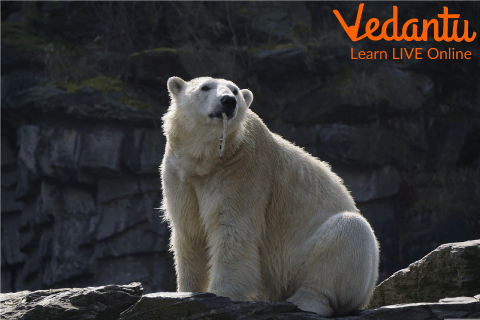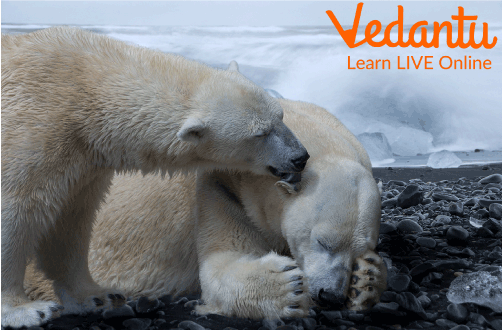




Introduction
What is the first thing that comes to your mind when you hear the name polar bear? White, furry bears, right? Polar Bears are large, primarily snow-white organisms which live in extremely cold climates and are usually found in the polar regions of the earth. They can survive in such cold weather because of their thick coat of fur. They usually feed on arctic foxes and the other organisms which live in the cold water around them.
In this article, we will discuss some interesting facts about polar bears and also some polar bear characteristics and polar bear special features.
Polar Bear Characteristics

Polar Bear
Polar bears have 42 teeth.
Polar Bears have very nice stamina, they can swim for days without getting tired.
Polar bears however cannot swim that fast. They can’t even outswim a seal in water which is why they mainly rely on their great sense of smell to catch their prey which is the seal.
Polar bears majorly have a high-fat diet, that is fat makes up more than half of their body weight.
Due to climate change, their population is slowly declining.
Polar Bear Special Features
A polar bear’s skin is black even though its thick coat of fur may appear to be white, it is in reality transparent.
A male polar bear can weigh up to 680 kg, however, female polar bears rarely weigh up to even half of that.

Male and Female Polar Bears
They have almost a 10 cm thick bubbler skin which is majorly responsible for keeping them warm.
Polar bears have an excellent sense of smell, they can detect a smell from as far away as a mile, which is 1.6 km.
Interesting Facts About Polar Bears
Some facts about Polar Bear are mentioned below:
Polar bear lives in the Arctic regions.
It is the largest carnivore that lives on land.
They can eat organisms like arctic foxes, but most of their diet consists of seals.
The scientific name for polar bears is ‘Ursus maritimus’.
Scientists claim that there are only 20000 polar bears in total, on earth.
A polar bear was a mascot in the winter Olympics of 1988, which took place in Canada.
A group of polar bears is known as a pack or a sleuth.
Sample Questions
State whether the statements mentioned below are true or not:
1. Polar bears live in extremely cold climates.
Ans: True.
2. They are usually white.
Ans: False, they are black but they appear to be white since their fur is translucent, which reflects the white snow.
3. Their main food is the arctic fox.
Ans: False, they mainly depend on seals as primary source of their food.
4. They cannot outswim a seal.
Ans: True.
Learn By Doing
Complete the statements that follow by filling in the blanks:
1. Male Polar Bears weigh up to _______ kgs.
Ans: 680
2. Polar Bears have _____ teeth.
Ans: 42
3. Polar Bears have a thick layer of _____ which helps them survive in the cold.
Ans: bubbler
Summary
Polar Bears are huge organisms which appear to be white but are black, and are primarily found in extremely cold climates of the arctic or the polar regions. They have huge bodies and mainly rely on seals living in the water around them as a source of food. They have a very nice sense of smell which help them in hunting seals since they are slower swimmers. They also have thick bubbler fat which helps them survive in the extremely cold climate by keeping them warm.
FAQs on Facts About Polar Bears for Kids
1. What are some interesting facts about polar bears for kids?
Polar bears are fascinating animals with many unique features. Here are a few key facts:
Their skin is actually black, not white or pink. This helps them absorb heat from the sun.
Their fur is not white but is made of clear, hollow tubes that scatter light, making them appear white. This provides excellent camouflage in the snow.
They have an incredible sense of smell and can detect a seal from nearly 20 miles away.
They are classified as marine mammals because they spend most of their lives on sea ice and in the ocean.
2. How do polar bears stay so warm in the freezing Arctic?
Polar bears have amazing adaptations to survive the cold. They have a thick layer of fat, called blubber, which can be up to 11 cm thick and acts as insulation. On top of this, they have two layers of fur—a dense undercoat and longer, hollow guard hairs. This combination traps air and keeps them warm both in the freezing water and on the ice.
3. What do polar bears eat?
Polar bears are carnivores, and their diet is high in fat, which is essential for survival in the cold. Their primary food source is seals, particularly ringed and bearded seals. They hunt them from the edge of sea ice. When their main food is scarce, they may also eat other animals like small whales, walruses, birds, or scavenge on carcasses.
4. Why are polar bears considered such good swimmers?
Polar bears are powerful swimmers and can swim for long distances and for many hours at a time. They use their large front paws, which are slightly webbed, to propel themselves through the water like paddles. Their hind legs and feet act as rudders, helping them steer. This ability is crucial for moving between ice floes to hunt for food.
5. What is a polar bear's home in the Arctic like?
A polar bear's home, or habitat, is the icy Arctic region, including countries like Canada, Russia, Greenland, Norway, and the United States (Alaska). They are heavily dependent on sea ice, which they use as a platform for hunting, travelling, and breeding. Mother polar bears dig dens in deep snowdrifts to give birth and protect their newborn cubs from the harsh weather.
6. How long do polar bear cubs stay with their mother?
A polar bear cub stays with its mother for about two to three years. During this important period, the mother teaches her cubs all the essential survival skills they will need. This includes how to hunt for seals, how to conserve energy, and how to navigate the challenging Arctic environment before they are ready to live independently.
7. What is the average lifespan of a polar bear?
In the wild, polar bears typically live for 15 to 18 years, although some have been known to live up to 30 years. The first year of life is the toughest for a cub, and their survival largely depends on the health and hunting success of their mother. The harsh conditions of the Arctic environment present many challenges throughout their lives.









